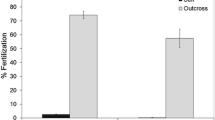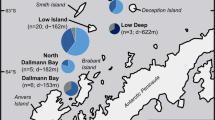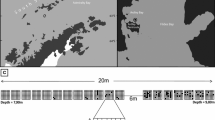Abstract
Previous research on gametic incompatibility in marine invertebrates suggests that for highly dispersive marine invertebrate species, barriers to fertilization among closely related taxa are often incomplete and sometimes asymmetric. The nature of these barriers can dramatically affect the patterns of gene flow and genetic differentiation between species, and thus speciation. Blue mussels, in the genus Mytilus, are genetically distinct in allopatry yet hybrids are present wherever any two species within the group co-occur. The present study sampled M. edulis (L.) and M. trossulus (Gould) in May and June 2001 from the East Bay section of Cobscook Bay, Maine, USA (latitude 44°56′30″N; longitude 67°07′50″W), where the two species are sympatric. Gamete incompatibility was investigated in a series of laboratory fertilizations carried out in July 2001. The proportion of fertilized eggs typically exceeded 80% at sperm concentrations of 103–104 ml−1 among intraspecific matings (n=18), but was <30% even at sperm concentrations in excess of 105–106 ml−1 for interspecific matings (n=13). Further analysis indicated that approximately 100- to 700-fold higher sperm concentrations were required to achieve 20% fertilization in interspecific matings relative to intraspecific matings, indicating strong barriers to interspecific fertilization. The proportion of fertilized eggs did not follow this general pattern in all matings, however. The eggs from two (out of five) M. edulis females were almost as receptive to M. trossulus sperm as they were to M. edulis sperm. In contrast, the eggs from all M. trossulus females (n=3) were unreceptive to M. edulis sperm, suggesting that fertilization barriers between these species may be asymmetric. Given the experimental design employed in this study, the results are also consistent with a strong maternal or egg effect on the level of interspecific gamete compatibility in M. edulis.





Similar content being viewed by others
References
Arnold ML (1997) Natural hybridization and evolution. Oxford University Press, New York
Banks MA, McGoldrick DJ, Borgeson W, Hedgecock D (1994) Gametic incompatibility and genetic divergence of Pacific and Kumamoto oysters, Crassostrea gigas and C. sikamea. Mar Biol 121:127–135
Bates JA, Innes DJ (1995) Genetic variation among populations of Mytilus spp. in eastern Newfoundland. Mar Biol 124:417–424
Biermann CH (1998) The molecular evolution of sperm bindin in six species of sea urchins (Echinodia: Strongylocentrotidae). Mol Biol Evol 15:1761–1767
Bierne N, David P, Boudry P, Bonhomme F (2002) Assortative fertilization and selection at larval stage in the mussels Mytilus edulis and M. galloprovincialis. Evolution 56:292–298
Boecklen WJ, Howard DJ (1997) Genetic analysis of hybrid zones: numbers of markers and power of resolution. Ecology 78:2611–2616
Buss LW, Yund PO (1989) A sibling species group of Hydractinia in the northeastern United States. J Mar Biol Assoc UK 69:857–874
Butlin R (1989) Reinforcement of pre-mating isolation. In: Otte D, Endler JA (eds) Speciation and it's consequences. Sinauer, Sunderland, pp 158–179
Comesaña AS, Sanjuan A (1997) Microgeographic allozyme differentiation in the hybrid zone of Mytilus galloprovincialis Lmk. and M. edulis L. on the continental European coast. Helgol Meeresunters 51:107–124
Comesaña AS, Toro JE, Innes DJ, Thompson RJ (1999) A molecular approach to the ecology of a mussel (Mytilus edulis–M. trossulus) hybrid zone on the east coast of Newfoundland, Canada. Mar Biol 133:213–221
Dobzhansky T (1940) Speciation as a stage in evolutionary divergence. Am Nat 74:312–321
Garbers DL (1989) Molecular basis of fertilization. Annu Rev Biochem 58:719–742
Gardner JPA (1994) The structure and dynamics of naturally occurring hybrid Mytilus edulis and M. galloprovincialis (Bivalvia, Mollusca) populations: review and interpretation. Arch Hydrobiol Suppl 99:37–71
Gardner JPA, Thompson R J (2001) The effects of coastal and estuarine conditions on the physiology and survivorship of the mussels Mytilus edulis, M. trossulus and their hybrids. J Exp Mar Biol Ecol 265:119–140
Gosling EM (1992) Systematics and geographic distribution of Mytilus. In: Gosling EM (ed) The mussel Mytilus: ecology, physiology, genetics, and culture. Elsevier, New York, pp 1–20
Heath DD, Rawson PD, Hilbish TJ (1995) PCR-based nuclear markers identify alien blue mussel (Mytilus spp.) genotypes on the west coast of Canada. Can J Fish Aquat Sci 52:2621–2627
Hellberg ME, Vacquier VD (1999) Rapid evolution of fertilization selectivity and lysin cDNA sequences in teguline gastropods. Mol Biol Evol 16:839–848
Hilbish TJ, Bayne BL, Day A (1994) Genetics of physiological differentiation within the marine mussel genus Mytilus. Evolution 48:267–286
Johannesson K, Kautsky N, Tedengren M (1990) Genotypic and phenotypic differences between Baltic and North Sea populations of Mytilus edulis evaluated through reciprocal transplantations. II. Genetic variation. Mar Ecol Prog Ser 59:203–210
Koehn RK, Hall JG, Innes DJ, Zera AZ (1984) Genetic differentiation of Mytilus edulis in eastern North America. Mar Biol 70:117–126
Knowlton N, Maté J, Guzman H, Rowan R (1997) Direct evidence for reproductive isolation among the three species of the Montastraea annularis complex in Central America (Panama and Honduras). Mar Biol 127:705–711
Leighton DL, Lewis CA (1982) Experimental hybridization in abalone. Int J Invertebr Reprod Dev 5:273–282
Lessios HA, Cunningham CW (1990) Gametic incompatibility between species of the sea urchin Echinometra on the two sides of the Isthmus of Panama. Evolution 44:933–941
Mallet AL, Carver CE (1995) Comparative growth and survival patterns of Mytilus trossulus and Mytilus edulis in Atlantic Canada. Can J Fish Aquat Sci 52:1873–1880
Maloy A, Barber BJ, Rawson PD (2003) Gametogenesis in a sympatric population of blue mussels, Mytilus edulis and Mytilus trossulus, from Cobscook Bay, Maine (USA). J. Shellfish Res (in press)
McCartney MA, Lessios HA (2002) Quantitative analysis of gametic incompatibility between closely related species of neotropical sea urchins. Biol Bull (Woods Hole) 202:166–181
McDonald JH, Seed R, Koehn RK (1991) Allozymes and morphometric characters of three species of Mytilus in the Northern and Southern Hemispheres. Mar Biol 111:323–333
Metz EC, Palumbi SR (1996) Positive selection and sequence rearrangements generate extensive polymorphism in the gamete recognition protein bindin. Mol Biol Evol 13:397–406
Metz EC, Kane RE, Yanagimachi H, Palumbi SR (1994) Fertilization between closely related sea urchins is blocked by incompatibilities during sperm–egg attachment and early stages of fusion. Biol Bull (Woods Hole) 187:23–34
Neter J, Wasserman W, Kutner MH (1985) Applied linear statistical models. Irwin, Homewood, Ill.
Palumbi SR (1992) Marine speciation on a small planet. Trends Ecol Evol 7:114–118
Palumbi SR (1994) Genetic divergence, reproductive isolation, and marine speciation. Annu Rev Ecol Syst 25:547–572
Palumbi SR (1999) All males are not created equal: fertility differences depend on gamete recognition polymorphisms in sea urchins. Proc Natl Acad Sci USA 96:12632–12637
Pawlik J (1988) Larval settlement and metamorphosis of sabellariid polychaetes, with special reference to Phragmatopoma lapidosa, a reef-building species, and Sabellaria floridens, a non-gregarious species. Bull Mar Sci 43:41–60
Pernet B (1999) Gamete interactions and genetic differentiation among three sympatric polychaetes. Evolution 53:435–446
Rawson PD, Hilbish TJ (1995) Evolutionary relationships among the male and female mitochondrial DNA lineages in the Mytilus edulis species complex. Mol Biol Evol 12:893–901
Rawson PD, Joyner K, Hilbish TJ (1996) Evidence for intragenic recombination within a novel genetic marker that distinguishes mussels in the Mytilus edulis species complex. Heredity 77:599–607
Rawson PD, Hayhurst S, Vanscoyoc B (2001) Species composition of blue mussel populations in the northeastern Gulf of Maine. J Shellfish Res 20:31–38
Riginos C, McDonald JH (2003) Positive selection on an acrosomal sperm protein, M7 lysin, in three species of the mussel genus Mytilus. Mol Biol Evol 20:200–207
Strathmann RR (1981) On barriers to hybridization between Strongylocentrotus droebachiensis (O.F. Muller) and S. pallidus (G.O. Sars). J Exp Mar Biol Ecol 55:39–47
Swanson WJ, Vacquier VD (1997) The abalone egg receptor for sperm lysin is a giant multivalent molecule. Proc Natl Acad Sci USA 94:6724–6729
Swanson WJ, Vacquier VD (1998) Concerted evolution in an egg receptor for a rapidly evolving abalone sperm protein. Science 281:710–712
Swanson WJ, Vacquier VD (2002) The rapid evolution of reproductive proteins. Nat Rev Genet 3:137–144
Takagi T, Nakamura A, Ryusaku D, Kyozuka K (1994) Isolation, characterization, and primary structure of three major proteins obtained from Mytilus edulis sperm. J Biochem 116:598–605
Toro JE, Thompson RJ, Innes DJ (2002) Reproductive isolation and reproductive output in two sympatric mussel species (Mytilus edulis, M. trossulus) and their hybrids from Newfoundland. Mar Biol 141:897–909
Väinöla R, Hvilsom MM (1991) Genetic divergence and a hybrid zone between Baltic Sea and North Sea Mytilus populations (Mytilidae: Mollusca). Biol J Linn Soc 43:127–148
Varvio S-L, Koehn RK, Väinöla R (1988) Evolutionary genetics of the Mytilus edulis complex in the North Atlantic region. Mar Biol 98:51–60
Vermeij GJ (1991) Anatomy of an invasion: the trans-Arctic interchange. Paleobiology 17:281–307
Vogel H, Czihak G, Chang P, Wolf W (1982) Fertilization kinetics of sea urchin eggs. Math Biosci 58:189–216
Waelbroeck C, Duplessy J-C, Michel E, Labeyrie L, Paillard D, Duprat J (2001) The timing of the last deglaciation in North Atlantic climate records. Nature 412:724–727
Wilhelm R, Hilbish TJ (1998) Assessment of natural selection in a hybrid population of mussels: evaluation of exogenous vs endogenous selection models. Mar Biol 131:505–514
Acknowledgements
C. Slaughter participated in this research as part of the National Science Foundation Research Experience for Undergraduates program at the Darling Marine Center (OCE-99-10188). Additional support was provided by the University of Maine Sea Grant Program under contract 99-343 and Hatch funds provided by the U.S. Department of Agriculture and the Maine Agriculture and Forestry Experiment Station (project no. ME08510) to P. Rawson; P. Yund was supported by funding from the National Science Foundation (OCE-01-22031). A previous draft of this manuscript was strengthened appreciably by comments from E. Fisher. This is Maine Agricultural and Forest Experiment Station external publication no. 2636 and contribution no. 378 from the Darling Marine Center. We certify that the research described within this document complies with the current laws of our country.
Author information
Authors and Affiliations
Corresponding author
Additional information
Communicated by J.P. Grassle, New Brunswick
Rights and permissions
About this article
Cite this article
Rawson, P.D., Slaughter, C. & Yund, P.O. Patterns of gamete incompatibility between the blue mussels Mytilus edulis and M. trossulus . Marine Biology 143, 317–325 (2003). https://doi.org/10.1007/s00227-003-1084-x
Received:
Accepted:
Published:
Issue Date:
DOI: https://doi.org/10.1007/s00227-003-1084-x




